-

人教版高中英语必修4A taste of English Humor说课稿3篇
Then I would ask them to think of a funny English or Chinese and tell it to partners. While telling stories, they can use expressions and some acting to help make the story funny. 5 minutes would be given to do this.Those stories they told there will be the material for their writing. Soletting them tell it at first is helpful. And they can make a difference between telling a funny story and writing it down. Generally speaking, it is difficult forstudents to write well because they don’t know what to write and how to write. Asking them to tell their own stories at first can help them come up with what to write.After their telling, I would invite someone to share his/her story with all of us and I would write it down on the blackboard.This example story would be used as a sample to illustrate the format of funny story. Different from a story from teacher or textbook, a story from students can obviously become a interesting material to draw students’ attention.Then I would ask the whole class to put this story into several parts. It might be a little bit difficult for them. So I would ask them to find out whether all the sentences are necessary. After delete some sentences, there are 6 sentences left behind. Then they can easily put them into three parts. After interaction with students, I would teach them the right terms for each part and conclude the format of funny story.This step is the key and difficult point in my lesson. So I mainly usetask-based teaching method in this part and the task for students was divided into several stages. With the separated difficult level, students can find there are usually three parts in writing. They can also learn to write without the unnecessary parts in the process of analyzing. And then I wouldn’t rush to tell them the right terms to them directly. Instead, I would ask them to name them by their own. A confused mind is better for acquiring knowledge.While-writing:Then I would give students 7 minutes to write down this story, without other requirements.With all the preparations in pre-writing, students’ difficulties were cleared. So it would be much easier for them to write down the story within 7 minutes. There are no other requirements because students’ first writing is actually a drafting. It would be revise and edit several times later. Writing, as a skill

人教版高中英语必修3Canada-the true north说课稿4篇
Good afternoon, teachers, It’s my great pleasure to be here sharing my lesson with you.The content of my lesson is Senior English Book 3 Unit 5 Canada —— “The true North”.I’ll be ready to begin this lesson from five parts. Analysis of the teaching material,the teaching methods,the studying methods, the teaching procedure,and Blackboard design.First, let me talk about the teaching material.Part 1 Teaching Material:This unit is about the introduction of Canada. By studying of this unit,we’ll enable the students to learn the geography, population, main cities, and natural beauty, natural resources of Canada. Through the training of the unit, it also requires students to learn some Language skills such as the expressions of position and emotions.So it plays an important part in the English teaching in this book.After studying the teaching material and analyzing the rule of children’s growing of mind,I think the teaching aims are the followings:1.Knowledge objects:(1) make the students learn some new words and phrases(2) make the students understand the content of the lesson.2.Ability objects:(1)To develop the Ss’ abilities of listening, speaking, reading and writing. Especially reading and speaking ability.(2) learn to talk about the characters of Canada in English(3)To train the Ss’ ability of working in pairs.3.Emotion objects:(1)Enable students to understand the characters of Canada..(2)Stimulate Ss to work hard to make China stronger.Part 2 Teaching Methods:I think helping students learn to master new words and phrases and improve the students’ reading and speaking ability is import and the difficult.According to the analysis of the teaching material and the import points and the difficult points,I will use the following teaching methods : question-guiding approach; fast-reading and careful reading; multi-media teaching methods; discussion

人教版高中英语必修4Women of achievement说课稿4篇
Good morning, distinguished judges:It’s my honor to talk about my teaching ideas with you. Today my topic is Women of Achievement. My presentation consists of six parts: the analysis of teaching material and student, teaching aims, key and difficult points, teaching and studying method, teaching procedures and blackboard design.First, let’s focus on the analysis of teaching material. This lesson is from New Senior English for China Student’s Book 4 Unit 1, the reading part. The main topic of the passage is the introduction of a student of Africanwildlife. After this lesson, the students will learn more information about her studying chimps in Africa, and their reading and speaking abilities can be developed as well.The next part is the analysis of students. My students are in senior high students. They have learnt English for many years, they’ve known many words and sentences, but their speaking and reading abilities are still not very good. So I will practice their speaking and reading abilities through different exercises.According to the New Standard Curriculum and the present situation, I set the teaching aims as follows: firstly, knowledge aims. Students can grasp some new words, such as worthwhile, move off. Moreover, students can understand the content of the passage and get familiar with the topic of studying chimps in wildlife. Secondly, ability aims. Students can use reading strategies such as skimming and scanning in reading process. Thirdly, emotional aims. Students can have the awareness of protecting animals and care about animals.Based on the above analysis, the key point of this lesson is to get the main idea and the detailed information from the passage; the difficult point is to talk about the wildlife protection and use reading strategies.

人教版高中英语必修3Festivals around the World说课稿3篇
Teaching plan for Unit 1 book3Good morning, teachers. It’s my great pleasure to be here because I can share my lesson with you and I can learn a lot from it. I’ll begin my lesson from the following four parts, the teaching material, the teaching methods, the studying methods and the teaching procedure.Firstly, let me talk about the teaching material. The content of my lesson is the reading passage festivals and celebrations of Unit 1 Festivals around the world. This passage is about festivals and celebrations. By studying this passage, we’ll enable the students to know that festivals exit everywhere, and many of festivals in different countries celebrate similar ideas. As we all know, the reading passage is the center of each unit. If the Ss can learn it well, it will be helpful to make the Ss learn the rest of this unit.After studying the teaching material, I think the teaching aims are as the followings:1. Knowledge aims:(1) The Ss can master the usage of the important words andexpressions.(2)The Ss can use the __________________ (grammar) in the proper situation.Make students know about the festivals all over the world and the detail of the festivals, such as origin, content, and the date of the holiday festivals.2. Ability aims:(1) Students can talk about festivals and celebrations in English(2) To improve the student’s reading ability, especially their skimming and scanning ability.3. Emotion aims:Make the Ss know about the foreign festivals, and respect other countries’ custom.Next, let’s come to the important points and the difficult points.The important point is how to make the Ss understand the text better and the difficult point is how can they talk about it. secondly, Teaching Methods:1. task-based Language Teaching2. Computer assisted language teaching.3. question-and–answer methodThirdly, Studying Methods:

人教版高中英语必修4Theme parks说课稿3篇
The oldest and the most popular park in the worldenjoy the exciting activities thereget close to the life-size cartoon characters like Mickey Mouse and Donald Duck Step 3 Pre-reading1.What do you suppose a theme park is ?2.What do you think you can see in a theme park?(1.It is a kind of amusement park which has a certain theme – that the whole park is based on. 2.buildings, castles, statues, rare animals and birds, and so on.) Step 4 Reading ----- Theme Parks –---- Fun and More Than Fun1.Predict : Read the title and the pictures on P. 34 and PredictWhat is the meaning of the title “Theme Park – Fun and more than fun”?(The title means that theme parks are fun to visit, but that they can also be educational and can offer useful information.)2.Skimming Fast read and answer:What activities can we take in a theme park?Amusement park: Bumper car Merry-go-round slide bungee jumping Free-fall rides Horror films Pirate ship Ferris wheel roller coaster3.Scanning Read again and you will find various theme parks are mentioned in the passage . Then what are they ?Theme parks: Sports theme park History theme park Culture theme park Marine or Ocean theme Park Future park Science theme park Disneyland4.Careful reading and find the main idea of each paragraph:THEME PARKS---- entertaining/ educationalPara.1 Traditional parks are places to go for relaxation and to have time away from our busy lives.Para.2 Theme parks are different They’re large and full of things to do, see and buy.Para.3 Theme parks are built around a single idea or theme. One example is a sports park.Para.4 Another kind of theme park is historical more and cultural and can be educational.Para.5 Disneylandwas the first theme park. It is based on the fantasy life and characters of Disney’s films.Para.6 Some examples of educational theme parks include sea world parks and science parks.

人教版高中英语必修3Healthy Eating说课稿4篇
Language learning needs a context, which can help the learners to understand the language and then can product comprehensible output, so computer has the advantages to make the materials attractive.Part 3 Learning MethodsTask-based, self-dependent and cooperative learningPart 4 Teaching ProcedureStep One Lead-in“Interest is the best teacher.” Therefore, at the very beginning of the class, I should spark the students’ mind to focus on the centre topic “the band”. I’ll show some pictures of food to attract their attention and then bring some questions.Question:What kind of food they like?What should go into a good meal?The answers must relate to the diet. After this, the students will be eager to know something about a balance diet and this is the very time to naturally lead the class into Step 2Step 2 Reading for information: skimming and scanning In this step, I use Task-based Language Teaching method, which can give students a clear and specific purpose while skimming and scanning the context.Task 1 General ideaThe students will be asked to just glance at the title and the pictures of the passage, and then guess what they will read in the text. And they’ll be divided into groups of four to have a discussion.The purpose is to inspire the students to read actively, not passively. In addition, the task is to develop the students’ reading skill by making prediction and to encourage the students to express their thoughts in English and cooperate with each other.Task 2 Main idea of each paragraphCooperative learning can raise the students’ interest and create an atmosphere of achievement. Based on this theory, I divide the whole class into 4 groups to skim the whole text and get the main idea of each paragraph.

人教版高中英语必修4Working The Land说课稿3篇
Knowledge objectives:(1) to make Ss grasp the usage of words, expressions and sentence structures: statistics, struggle, thanks to, rid of, some patterns for persuasion, the “ing” form as subject and object;(2)to use learnt knowledge to persuade sb.Ability objectives:(1) to develop Ss’ reading skills(skimming, scanning, word guessing);(2) to improve Ss’ speaking, communicating and cooperating skills.Emotional objectives:to make Ss know the contribution of Yuan,and learn his spirit and his simple life time.Teaching important and difficult points:(1) some words, expressions and sentence structures mentioned above;(2)the content of the text;(3)training their reading and speaking skills.Teaching methods: CLT, TBLT,QT.Learning strategies: CLS, QLS, TBLS.Teaching procedures:Step 1 lead-in: (1) teacher plays a piece of recent news from CCTV about the harvest of the super hybrid rice, and ask students whether they know Yuan or not, and talk about him and his contribution.(2)Brain storm: let Ss describe Yuan in their minds including his appearance, his living condition and so on.Step 2 fast reading tasks:(1)teacher introduces Yuan and super hybrid rice(2)make Ss read the text as fast as possible with questions. Such as: what’s the general ideaof this passage? What’s Yuan’ dream? (skimming and scanning skill)Step 3 intensive reading tasks(1)let Ss read the text silently, find topic sentence of each paragraph and draw the difficult sentences and the knowledge what they don’t understand.(words guessing)(2)teacher and Ss talk about the important words, expressions and sentences together, and ask Ss to retell the content of the text.(summarizing and paraphrasing)(3)teacher summarize this part.(4) read again following the courseware.

人教版高中英语必修3The million pound bank note说课稿3篇
在接下来的细读环节,我套用了高考对阅读理解的考查方式设置了5个问题,分别为三个推理判断题,一个细节题和一个主旨大意题。学生需要对文章的内容进行分析、归纳、推理、猜测等高级思维活动才能做出正确的回答。【设计意图】这一过程是对学生进行细读的训练,培养学生获取特定信息和挖掘文章深层次信息的能力。第三环节:Intensive-reading (精读) 15′第三个环节精读,既是最重要的环节,也是突破本课重难点的关键。首先,让学生思考剧本中人物看到百万英镑前后的态度发生了怎样的变化。其次,让学生仔细阅读文章,找出可以表现人物态度变化的具体的语言和动作。最后,让学生总结人物的态度发生变化的根本原因是什么,从而引出Money Talks, 供学生思考。【设计意图】通过一系列的活动培养学生学习从人物的语言和动作探究人物的心理,使学生进一步体会戏剧语言的魅力,从而对文章背后所反映的社会问题进行思考,也为下一步的讨论环节做好铺垫。
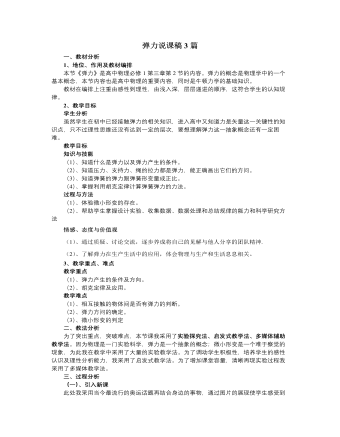
人教版新课标高中物理必修1弹力说课稿3篇
基于以上分析,为使本堂课围绕重点、突破难点,同时让学生在课堂教学中能力得到提高,我设计如下教学过程。(一)创设情景认识形变由同学们已有的形变知识入手,引入新课。教师演示:①弹簧的压缩形变;②弹簧的拉伸形变③视频播放:竹竿形变、钢丝的扭转形变。得出形变的概念及各类形变。[设计意图:我从生活情景中引入新课,是为了激发学生的好奇心,为学生学习重点和难点内容作铺垫。]设问:摩天大楼在风的吹拂下会不会摆动,发生形变吗?演示微小形变放大实验:由于这种形变不容易观察,会使学生产生疑问:到底有没有发生形变?解决的办法是微小形变的演示实验。为什么光点会往下移?让学生带着问题思考后得出结论:是由于桌面发生了形变,但是形变不明显。为后面解决压力和支持力都是弹力做好铺垫。[设计意图:使学生知道“放大”是一种科学探究的方法。]
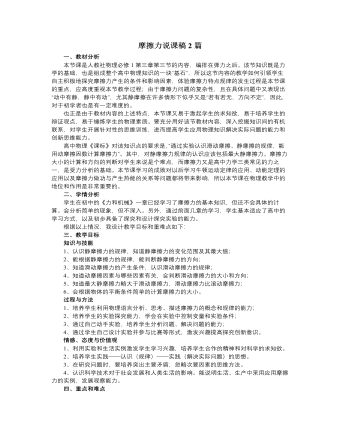
人教版新课标高中物理必修1摩擦力说课稿2篇
本节课是人教社物理必修1第三章第三节的内容,编排在弹力之后。该节知识既是力学的基础,也是组成整个高中物理知识的一块“基石”,所以这节内容的教学如何引领学生自主积极地探究摩擦力产生的条件和影响因素,体验摩擦力特点规律的发生过程是本节课的重点,应高度重视本节教学过程;由于摩擦力问题的复杂性,且在具体问题中又表现出“动中有静,静中有动”,尤其静摩擦在许多情形下似乎又是“若有若无,方向不定”,因此,对于初学者也是有一定难度的。也正是由于教材内容的上述特点,本节课又易于激起学生的求知欲,易于培养学生的辩证观点,易于锤炼学生的物理素质。要充分用好该节教材内容,深入挖掘知识间的有机联系,对学生开展针对性的思维训练,进而提高学生应用物理知识解决实际问题的能力和创新思维能力。高中物理《课标》对该知识点的要求是,“通过实验认识滑动摩擦、静摩擦的规律,能用动摩擦因数计算摩擦力”。其中,对静摩擦力规律的认识应该包括最大静摩擦力。
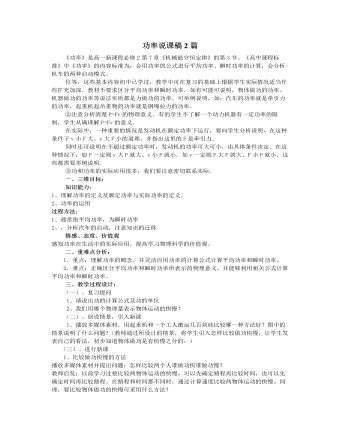
人教版新课标高中物理必修2功率说课稿2篇
(一)、复习提问1、请说出功的计算公式及功的单位2、我们用哪个物理量表示物体运动的快慢?(二)、创设情景,引入新课1、播放多媒体素材,用起重机和一个工人搬运几百块砖比较哪一种方法好?图中的情景说明了什么问题?(教师通过所设计的情景,将学生引入怎样比较做功快慢,让学生发表自己的看法,初步知道物体做功是有快慢之分的。)(三)、进行新课1、比较做功快慢的方法播放多媒体素材并提出问题:怎样比较两个人谁做功快谁做功慢?教师启发:以前学习过要比较两物体运动的快慢,可以先确定路程再比较时间,也可以先确定时间再比较路程。在路程和时间都不同时,通过计算速度比较两物体运动的快慢。同理,要比较物体做功的快慢可采用什么方法?
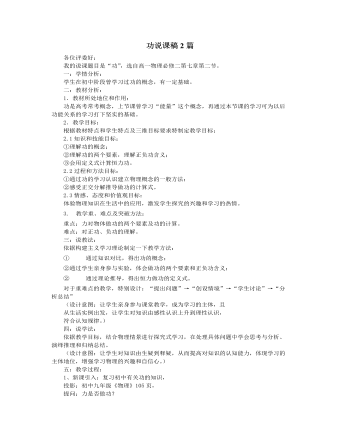
人教版新课标高中物理必修2功说课稿2篇
探究一:高中阶段功的含义是什么?投影:初中九年级《物理》105页学生思考:①图中物体的势能、动能分别如何变化?②物体能量的变化和做功是否存在关系?学生:分组讨论,得出结论:如果物体的能量发生变化时,说明有力对物体做了功。教师:进行点评和小结(设计意图:对初中知识深化理论认识,并为以后功能关系的教学作准备)探究二:力对物体做功的两个要素是什么?情景再现:找体重相对悬殊的两位同学,①A同学试图抱起B同学,但没成功。②B同学抱起A同学在教室内匀速走动。学生思考:在①中,A是否对B做功?在②中,B是否对A做功?学生:分析得出做功的两要素:物体受到力的作用,并且在力的方向上发生位移.教师:让学生分别例举生活中力对物体做功和不做功的例子,(设计意图:让学生亲身参与课堂实验,烘托课堂气氛,相互协作增进同学情谊)探究三:如果物体的位移不再力的方向上,那么力是否还对物体做功?
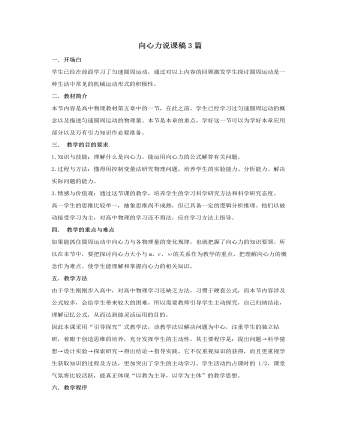
人教版新课标高中物理必修2向心力说课稿3篇
通过这个示例呢,我们可以得到解决向心力问题的一般的步骤,确定对象,找出轨迹,找出圆心,然后进行受力分析,让同学们参考这样的步骤,逐步的解决圆周运动的问题,对于变速圆周运动,我通过链球运动进行引入,这里是一个链球运动的视频,在同学们观看视频之前,我给同学们提出问题,链球收到绳子的拉力,做的是匀速圆周运动吗? 然后再课堂上我们再做一个小实验, 我们可以通过改变拉线的方式来调节小球的速度大小吗? 那么对小球,做加速圆周运动,进行受力分析,我们可以看到,小球做加速运动时,他所受到的力,并不是严格通过轨迹的圆心,在进行分析的时候,特别强调,小桶所受力的切线方向分力,和法线方向分力,切线方向分力,改变小球运动速度大小,法线方向分力,改变了小球运动的方向,法线方向的分力,在这里就是向心力,产生了向心加速度,通过这样一个例子进行分析,同学们是比较容易理解的,

幼儿交通安全教案5篇
一、活动导入 给幼儿看过马路以及红绿的的图片,让幼儿对红绿灯及斑马线有初步的认识。 提问幼儿红绿灯亮的时候应该怎么做。 二、活动过程 1、选出一些小朋友扮演红绿黄交通灯以及小汽车,老师扮演交通警察。 2、给小朋友讲解活动的内容。 3、扮演小汽车及红绿灯的小朋友戴上活动道具帽子,开始在虚拟马路上站岗及走动。 4、小朋友放学后排着队等待绿灯过马路。红灯亮,路上很多小汽车快速奔走,小朋友在马路旁等待。
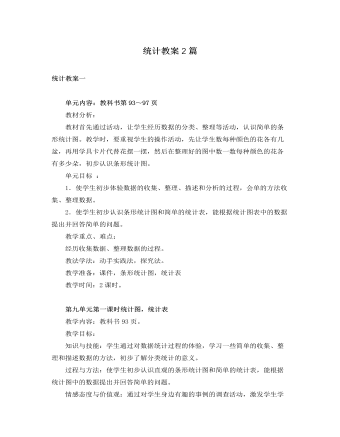
人教版新课标小学数学一年级下册统计教案2篇
2、揭题:小朋友们,知道吗?刚才你们的学习过程其实就是统计的过程,这节课我们就一起来研究统计的有关知识。3、发统计图和统计表:根据你刚才收集的数据,完成统计图和统计表。实践活动(调查全班小朋友们喜欢的动物)统计表:(学具卡片)绿孔雀非洲象大熊猫袋鼠梅花鹿河马统计图:(学具卡片)绿孔雀非洲象大熊猫袋鼠梅花鹿河马4、出示统计图和统计表。(1)通过小朋友们的统计,你能发现什么?(2)你可以提出什么问题?三、总结:1、日常生活中有许多事情可以用统计解决,你能说一说吗?2、谈谈这节课你的收获。作业布置:第二课时、练习教学内容:完成练习十七的2——4题。教学目标:巩固本单元所学的内容。教学过程:一、检查作业:1、小组互相交流自己调查的结果。2、展示几份。二、练习:练习十七1、第2题。(1)看图,明确题意。(2)先用自己喜欢的方法统计。(3)完成统计表及问题。(4)集体订正。
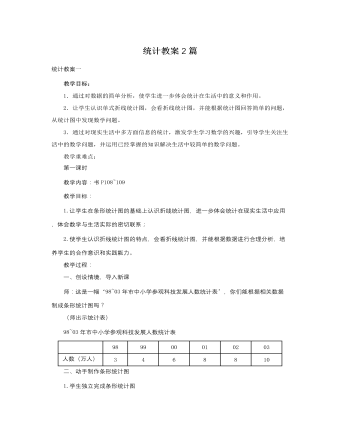
人教版新课标小学数学四年级下册统计教案2篇
制作前先让学生说说每格表示几个单位然后再制作统计图。2.小组交流作品,复习回顾‘条形统计图’的相关信息“制作步骤、特点”A学生根据条形统计图说说发现了哪些信息?B学生小组评价优秀作品;C全班交流优秀作品。三、对比条形统计图和折线统计图,认识折线统计图的特点1.师演示“98~03年市中小学参观科技发展人数折线统计图”,学生观察。师:这个统计图是怎样完成的?师和生一起分析折线统计图,教师演示其中的一个数据的画法,让生知道是这张统计图是如何画的。师:你们对比这两个统计图,看看它们有什么异同?学生先独立思考,再在小组内交流。2.小结:条形统计图和折线统计图相同点和不同点。教师把两种统计图的相同点和不同点板书出来。3.认识折线统计图,发现折线统计图的特点师:你能从折线统计图中发现哪些信息?有什么感想?引导学生观察参加科技发展人数的变化情况,并谈自己的感想,培养学生关心周围事物的兴趣并引导学生积极参加社会实践活动。
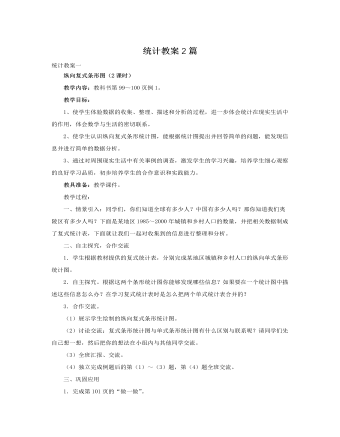
人教版新课标小学数学四年级上册统计教案2篇
教学目标:1、经历简单的收集、整理、描述和分析数据的过程。2、使学生初步了解数据的收集和整理过程,学会整理简单的数据,会看简单的统计表和统计图,会根据统计图表中的数据回答一些简单的问题。3、使学生体验解数据的收集、整理、描述和分析的过程,能发现信息并进行简单的数据分析。4、体会到数学知识与实际生活紧密联系,激发学生的学习兴趣,培养学生细心观察的良好学习品质。教学重点:绘制纵向复式条形统计图。教学难点:根据统计图发现问题、提出问题、解决问题。教具准备:课件。教学过程:一、情境导入:你们知道全球有多少人?中国有多少人吗?那你们知道自己所在的区有多少人吗?下面我们一起对收集到的信息进行整理和分析。二、探究新知:1、根据统计表,分别完成两个单式条形统计图2、根据两个条形统计图你能发现哪些信息?如果要在一个统计图中描述这些信息怎么办?在学习复式统计表时是怎么把两个单式统计表合并的?
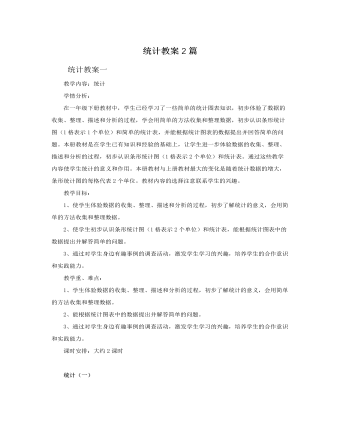
人教版新课标小学数学二年级上册统计教案2篇
1、让学生仔细观察,练习二十二1题图,你看到了什么?生:举手自由口答。2、师:根据这些信息,你能提出什么问题?板书学生提出问题在此基础上,师生重点解决问题3、小黑板出数统计表、统计图(1)学生在树上独立完成(2)上台展示并回答问题(3)师质疑:你还能提出哪些问题?[设计意图]:通过统计停车场每种车的数量,把解决问题和统计知识综合进来,巩固所学统计知识和解决问题,体验怎样收集信息。二、生活应用1、出示97页2题(1)同桌观察理解(2)独立在书上完成2、互相纠错评价,教师巡视辅导。3、质疑:你还能提出什么问题?[设计意图]:让学生通过数“正”字来收集信息。三、开放实践1、p97页3题4题(1)学生以小组为单位展开讨论统计。(1、2、3组做3题,4、5、6组做4题)(2)展示师生互评[设计意图]:让学生发挥主体性去调查收集数据,根据自己的能力提出并回答一些问题。
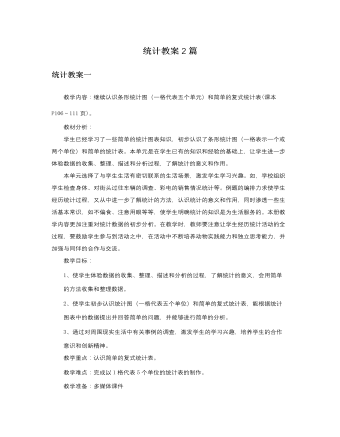
人教版新课标小学数学二年级下册统计教案2篇
2.采用比较简便的方法,师生合作完成“数据的收集与整理(强调数据的准确性),学生独立完成“表格的填写”。3.小组内讨论完成“表格的分析”。4.全班进行反馈。(意在培养独立收集、整理数据的能力,核对数据的准确性,并且扩大提问题的参与面,让学生也能启动智慧、享受快乐;及时反馈信息,调整教学目标)四、全课总结1.通过今天的学习,同学们有哪些收获?2.应用延伸。(课本第112页练习二十二第1题)五、布置作业教后反思统计是日常生产生活中常用和实用的工具,因此统计也是小学生必备的能力之一。但是统计的教学较为枯燥无味,教师往往会轻视统计的教学,忽略学生能力方面的培养。在教学统计时,老师要激发学生学习统计的兴趣,创造各种情景,加强学生统计中的动手实践操作训练,同时在实际生活中加以运用,并逐步加大难度和密度,同时也需要知道,统计教学不要过分地浮夸,多给予学生统计的意义,使其明确学习的目的。
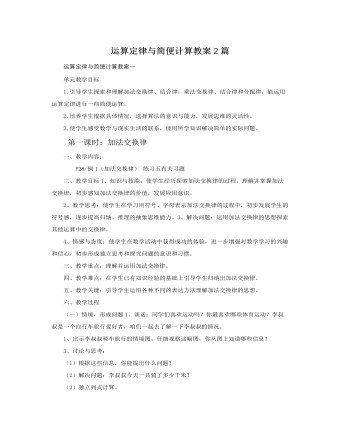
人教版新课标小学数学四年级下册运算定律与简便计算教案2篇
二、教学目标1、知识与技能:使学生经历探索加法交换律的过程,理解并掌握加法交换律,初步感知加法交换律的价值,发展应用意识。2、数学思考:使学生在学习用符号、字母表示加法交换律的过程中,初步发展学生的符号感,逐步提高归纳、推理的抽象思维能力。3、解决问题:运用加法交换律的思想探索其他运算中的交换律。4、情感与态度:使学生在数学活动中获得成功的体验,进一步增强对数学学习的兴趣和信心,初步形成独立思考和探究问题的意识和习惯。三、教学重点:理解并运用加法交换律。四、教学难点:在学生已有知识经验的基础上引导学生归纳出加法交换律。五、教学关键:引导学生运用各种不同的表达方法理解加法交换律的思想。六、教学过程(一)情境,形成问题1、谈话:同学们喜欢运动吗?你最喜欢哪项体育运动?李叔叔是一个自行车旅行爱好者,咱们一起去了解一下李叔叔的情况。1、出示李叔叔骑车旅行的情境图。仔细观察这幅图,你从图上知道哪些信息?

